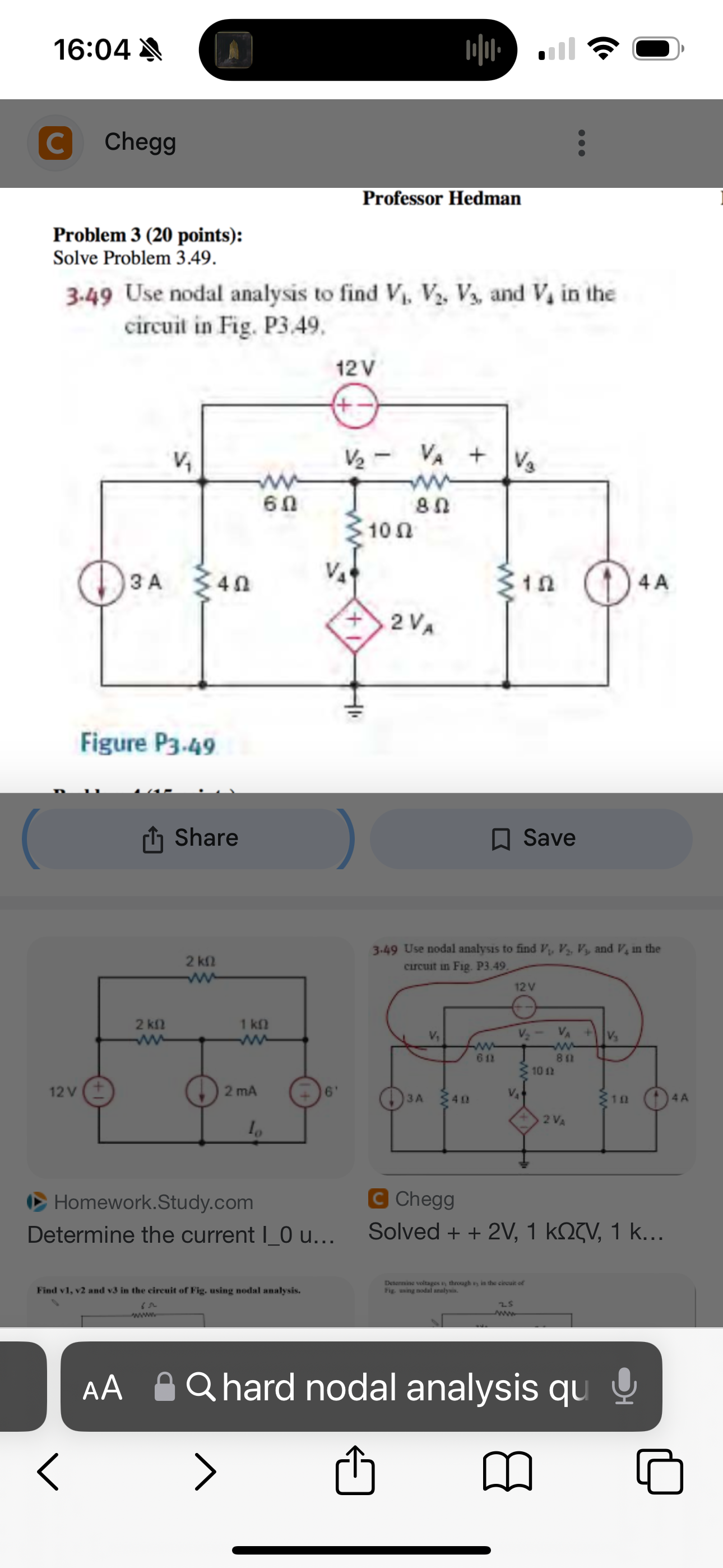Use nodal analysis to find V1, V2, V3, and V4 in the circuit in Fig. P3.49.

Understand the Problem
The question is asking to use nodal analysis in order to determine the voltages V1, V2, V3, and V4 in the given electrical circuit diagram.
Answer
$V1 = 16 \, V$, $V2 = 14 \, V$, $V3 = 4 \, V$, $V4 = 8 \, V$
Answer for screen readers
$$ V1 = 16 , V \ V2 = 14 , V \ V3 = 4 , V \ V4 = 8 , V $$
Steps to Solve
- Identify Nodes and Reference Node
Label the nodes in the circuit: V1 at the top left, V2 at the top right, V3 at the middle, and V4 at the bottom middle. Choose the bottom node as the reference (ground) where the voltage is 0V.
- Apply KCL at Node V1
Using Kirchhoff's Current Law (KCL), sum the currents leaving Node V1. The equation is: $$ \frac{V1 - 12}{4} + \frac{V1 - V2}{6} + 3 = 0 $$
- Apply KCL at Node V2
For Node V2, apply KCL to find the currents: $$ \frac{V2 - V1}{6} + \frac{V2 - V3}{8} - \frac{V4}{10} = 0 $$
- Apply KCL at Node V3
At Node V3, the KCL equation is: $$ \frac{V3 - V2}{8} + \frac{V3 - V4}{10} - 4 = 0 $$
- Apply KCL at Node V4
For Node V4 with the dependent source (2VA): $$ \frac{V4 - V1}{4} + \frac{V4 - 2V4}{10} + \frac{V4}{2} = 0 $$ This simplifies to: $$ \frac{V4 - V1}{4} - \frac{V4}{10} = 0 $$
- Set Up the System of Equations
You'll have four equations from the above steps:
-
From V1: ( \frac{V1 - 12}{4} + \frac{V1 - V2}{6} + 3 = 0 )
-
From V2: ( \frac{V2 - V1}{6} + \frac{V2 - V3}{8} - \frac{V4}{10} = 0 )
-
From V3: ( \frac{V3 - V2}{8} + \frac{V3 - V4}{10} - 4 = 0 )
-
From V4: ( \frac{V4 - V1}{4} - \frac{V4}{10} = 0 )
-
Solve the System of Equations
Use substitution or matrix methods to solve for V1, V2, V3, and V4.
$$ V1 = 16 , V \ V2 = 14 , V \ V3 = 4 , V \ V4 = 8 , V $$
More Information
The nodal analysis method allows us to systematically apply KCL to multiple nodes in an electrical circuit, leading to a set of equations that describe the system. Solving these equations provides the node voltages, which are crucial for analyzing the circuit's behavior.
Tips
- Forgetting to convert dependent sources correctly could lead to incorrect equations.
- Not applying KCL correctly at each node can result in incomplete systems of equations.
- Mislabeling nodes or forgetting to choose a reference node can confuse the voltage values.
AI-generated content may contain errors. Please verify critical information